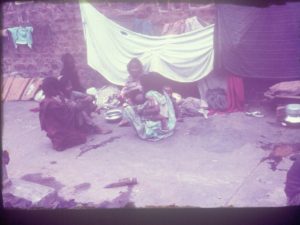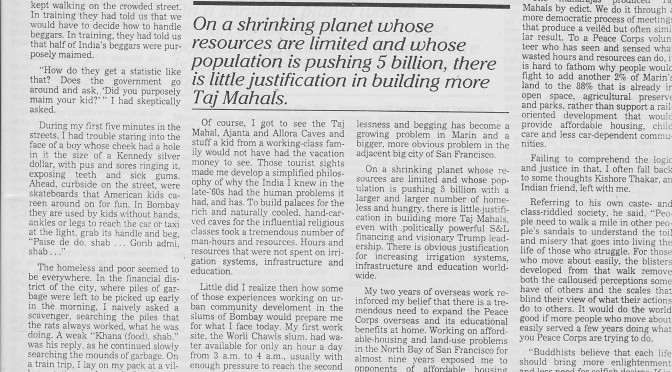Published Marin IJ Wednesday May 15, 1996
Traffic in Marin: Where do we go now?
Opinion Marin independent Journal
All aboard! The future won’t wait
Dwayne Hunn
In the late 1970s, Peter Calthorpe was an associate of State Architect to-be Sim Van der Ryn, working to establish a Solar Village at Hamilton Air Force Base. By the 1980s, Peter was on his own, preaching development Pedestrian Pocket communities where people could walk to and from parks, schools, work places and transit options other than the car nestled in suburbia’s omnipresent garage.
Pedestrian Pockets offered the opportunity to develop the community that ethnic neighborhoods of the 40’s and 50’s and Peter Calthorpe’s Sausalito houseboat neighbors had. Unfortunately, Marin’s presumed environmentalists — and the power structure they supported, wouldn’t listen to concepts that allowed clustered communities of affordable housing to be built on at least 13+ large parcels that then laid adjacent to Marin and Sonoma’s Northwest Pacific Right of Way.
For years, few seemed to pay attention to Calthorpe’s rejuvenated concept or to pay for his services. Luckily, his Berkeley students helped keep him going until the rest of the country realized the good sense of Pedestrian Pockets and paid him to do them.
In a shrinking world where our lifestyle consumes more than its proportional share, and our lack of community produces an abundance of dysfunctional acts, Pedestrian Pockets design part of the needed solutions.
In 1991 Peter was the keynote speaker for the region’s first Land Use and Transportation Conference sponsored by North Bay Transportation & Management Association, the first such association in Northern California. Twenty regional leaders participated in the all day conference, where 400 listened and participated with the panels.
On Saturday, a similar conference will be held with Phil Erickson of Calthorpe & Associates serving as a keynote speaker. Phil will report on a study that Peter has tried to fund for 20 years — a Sonoma/Marin transportation and land-use study. Twenty years ago those 13+ large parcels were less fettered, with planned or existing expensive suburban sprawl homes entwined amid a morass of costly curbs, gutters and dead end streets.
But it is better late than never for Marin and Sonoma counties to use their remaining land to support uses that enhance the environment through more sustainable developments that allow for beneficial reuse of the rail line with passenger and freight traffic.
Thanks to narrow-minded planning, Marin rates at the bottom of the Bay Region’s nine county list when its labor market independence is ranked. In Marin, 70 percent of county workers live here versus Sonoma’s comparable 94 percent. In Marin, 59 percent of employed county residents work here versus Sonoma’s comparable 82 percent. In Marin’s construction transportation, communications and public utilities industries, inbound-commutes hover near 50 percent versus Sonoma’s 10 percent.
Let’s hope Marin will waste no more time in providing land uses that will help make the rail line more economically viable. Even before Pedestrian Pockets are built, the existing rail line can help reduce environmental impacts. Consider:
- As development moves forward on Bel Marin Keys, Hamilton Field and St. Vincent/Silveira, wouldn’t it be more environmentally beneficial to import needed fill and building materials by train rather than by road hammering, pollution belching trucks?
And when you consider how much more fuel efficient trains are than cars, and how they, too, add to community building:
- Wouldn’t Marin’s true environmentalists want to start setting the environmental and community standards for other parts of the country that have the same opportunity we have?
Dwayne Hunn, who lives in Mill valley, was Executive Director of the North Bay TMA and now works on land use, transportation and political issues as well as with Excel Telecommunications.
- Developers need a new strategy
- Collected wisdoms on why Marin housing is so expensive:
- Federal bay refuge simply is too much
- A ’golden opportunity’ for whom?
- Preservation proposal is elitist
- St Vincent’s is a rare opportunity
- ‘Smart’ planning needed in Marin
- I see San Rafael in 2020, and it works
- 10 questions for San Rafael
- Oh, God, have mercy on our failures
- …but, from where I sit, they’re part of the problem
- Downzoning can punish community
- With no train can we really clean…
- All aboard! The future…
- Marin, why not think ‘regional’?
- Apathy never fixes anything
- Marin power/a closer look
- Pedestrian Pockets II
- Interviewing Angelo Siracusa — Bay Area Council boss
- Pedestrian pockets
- Everyone wants transit?
- NEH, NBTMA, County letters on Hamilton Proposed Development
- Traffic reducing proposals
- Points in favor of Hamilton
- Building a better Marin
- Rail/Highway alternative best with development “pockets’
- East San Rafael’s needs
- Address our housing needs
- Visionary Leaders needed
- Innovations at Novato’s Skylark project


